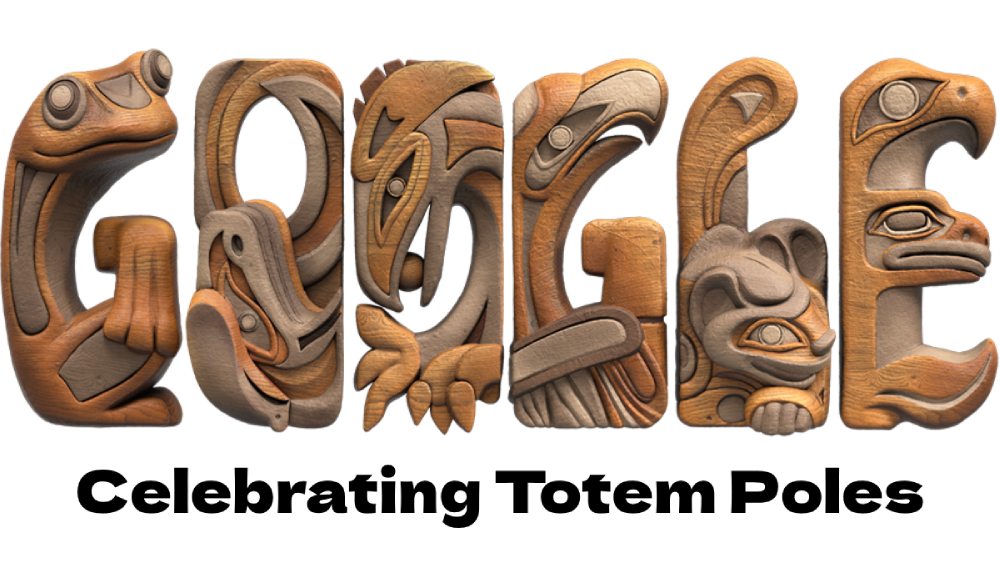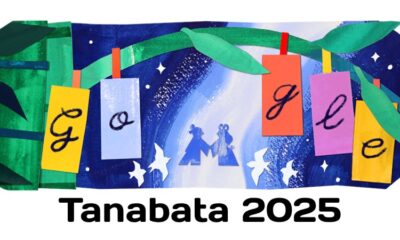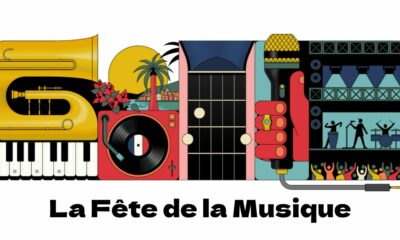Festivals & Events
Google Doodle Celebrates the Beautiful Artform of Totem Poles

Today’s Google Doodle honors the lovely art form of totem poles in observance of Indigenous Peoples’ Day. This Doodle honors totem poles, which are enormous carvings created by Pacific Northwest Coast Indigenous peoples that can symbolize clan identities, family crests, and ancestors’ stories. Originally, First Nations groups such as the Haida, Nuxalk (Bella Coola), Kwakwaka’wakw, Tsimshian, and Łingít carved these enormous pieces of wood. Alano Edzerza, a guest artist from Tahltan, Vancouver, made the Doodle artwork.
Totem poles are more than just pieces of art; they are wood carvings that tell profoundly symbolic stories. They remember events, tell stories, or symbolize the crests and ancestry of a family. A lot of these crests have animals that stand for family history, kinship, and identification.
The frog, wolf, raven, eagle, bear, whale, and thunderbird are among the animals that are portrayed in this Doodle. These colossal constructions also house mythological creatures, ancestors, and important historical figures, frequently arranged in a narrative sequence that can be “read” by those who comprehend the meaning.
On the Pacific Northwest Coast, totem poles are common, and western red cedar is used for the majority of the carvings. Although the world’s highest stands in British Columbia at almost 52 meters, these artworks are usually between 3 and 18 meters tall! A variety of tools, such as axes, chisels, and carving knives, are used in their manufacture.
By outlawing some indigenous customs, including the Potlatch, a ritual in which poles are raised, colonization endangered totem poles. Beautiful totem poles are being used as symbols of resistance against cultural incursion and survival.
Totem poles are monuments made by Pacific Northwest First Nations to honor and symbolize lineage, history, people, or events. In order to be seen within a society, totem poles are usually made of red cedar, a malleable wood that is somewhat available in the Pacific Northwest.
Native Americans from the Northwest Coast of the United States and Canada built the totem pole, which is a carved and painted log that is positioned vertically. Totem poles come in seven main varieties: memorial, or heraldic, poles, which are placed when a house changes hands to honor the previous owner and identify the current one; grave markers, or tombstones; house posts, which support the roof; portal poles, which have a hole through which a person enters the house; welcoming poles, which are placed at the edge of a body of water to identify the owner of the waterfront; mortuary poles, which hold the remains of the deceased; and ridicule poles, which have a prominent person’s likeness carved upside down.
The carvings on the totem poles highlight and divide the painted, flat surfaces of the symbolic animals and spirits they depict. Every pole typically contains one (like a grave marker) to several (like a family legend) animal images, all of which follow to standardized forms that are recognized by all Northwest Coast Native Americans; eagles, for example, always have downward-curved beaks, and beavers, for example, always have cross-hatched tails.
The term “totem” describes an ancestral or guardian creature, typically of a supernatural nature, who is respected and honored but not necessarily worshipped. The real or mythical animal engraved on a totem pole is significant because it represents the head of the household’s ancestry. Similar to how a rancher may have a bull on his brand or an Englishman a lion on his crest, the animal is used as a sort of family crest.
Tall totem poles with intricate carvings that tell a whole family legend in the form of a pictograph are more well-known, but actually much less common. This fable cannot be read in the usual sense of the word; interpretation of the pole requires knowledge of the history and customs of the clan in question as well as an awareness of the meaning of the symbols to the Native Americans. Every animal or spirit that is carved on the pole has a purpose, and when they are arranged sequentially on the pole, they form a significant symbol that is a part of a myth or story. However, without the assistance of an informed family narrator, it would be very difficult to accurately understand any combination of symbols.
Because it was costly to hire an artist to create a pole, the totem pole was also a sign of the owner’s wealth. The advent of high-quality metal tools and the prosperity from the fur trade allowed many chiefs to purchase these displays, which led to the zenith of totem pole carving in the early and middle 19th century. However, there aren’t numerous examples of this era left because the cedar poles rot and fall after 60 to 70 years due to the moist coastal atmosphere.
Totem poles are visual narratives of Indigenous heritage that capture history, culture, and spirituality; they are more than just carvings. They have resurfaced in modern times as potent emblems of Indigenous identity, having persevered through the hardships of colonization and repression. We appreciate the traditions and legacies of Indigenous communities by comprehending and honoring the history and significance of totem poles.
-

 Lifestyle3 weeks ago
Lifestyle3 weeks agoBob Gerace Discusses Coaching Themes: Confession, Reconciliation, Communication, Intimacy, and Fatherhood
-

 Business4 weeks ago
Business4 weeks agoFrom Monastery to Main Street: How a Former Monk Is Revolutionizing Executive Coaching for Tiny Businesses
-

 Education2 weeks ago
Education2 weeks agoAn Exclusive Interview With Holly Gold: The Heart and Vision Behind The Little Schools
-

 Sports4 weeks ago
Sports4 weeks agoNBA Season 2025-26: Full Schedule, Preview, Key Dates, Players, Teams and How to Watch Live
-

 Travel3 weeks ago
Travel3 weeks ago8000 Voices, One Vibe — Ludhiana Sang Every Word with Talwiinder at Bangr Arena
-

 Science4 weeks ago
Science4 weeks agoThings to Know about the Orionid Meteor Shower 2025, When and How to Watch
-

 Business2 weeks ago
Business2 weeks agoCorporate Event Catering in Manchester: What Businesses Need to Know (and why Manchester sets the bar)
-
Tech3 weeks ago
Harrington Quality Management System (HQMS): Flagship Platform of Harrington Group International
























